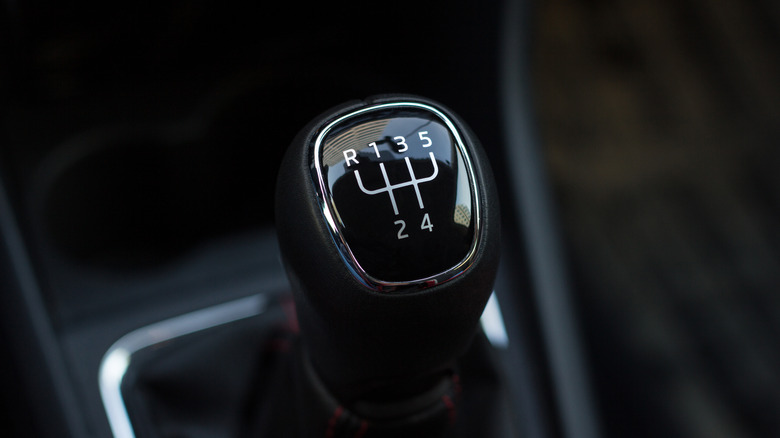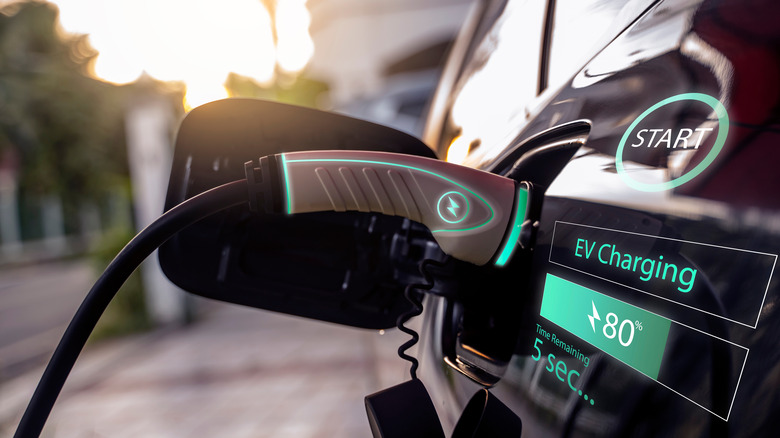The Real Reason Why Stick Shifts Are A Dying Breed
According to The New York Times, only 18% of drivers in the United States know how to drive a "four on the floor." Other numbers back up the notion that people's stick-shifting ways are dying: Edmunds reported that in 2020 there were a total of 327 new car models available in the U.S., and only 41 of those (13%) had a manual transmission option. In 2011 that number was almost triple, at 37% (via CNBC).
And the numbers keep dropping for what was once considered part and parcel of becoming a young adult: learning how to drive. But what is causing the decline of the three-pedal two-step? The answer is a complex spiderweb of socio-economic trends that have been secretly and simultaneously sticking to the stick shift for several decades.
Manual transmissions were cheaper to build, typically provided better gas mileage, and were easier to fix. Automatic transmissions were a pricey upgrade that allowed drivers to worry less about the actual act of driving, especially on hills and in the congestion of big cities.
However, as traffic increased in urban jungles, people found that constantly shifting gears in the slow-moving stop-and-go snarl of their daily commute was both tiring and cumbersome. Thus that sporty, racing fun of double clutching began fading from America's consciousness.
As traffic grew, so did the size of most American cars and the gas tanks in those cars. During the '50s and '60s, the U.S. seemingly had an endless supply of oil to fill all those tanks. But then came the Organization of Petroleum Exporting Countries (OPEC) oil crisis in 1973 that quadrupled the price of a barrel of oil from $2.90 to $11.65, causing unfathomable fuel shortages and long lines at the gas pumps.
We all had to drive 55
All of which had a two-fold effect in the United States. It changed the car industry by paving the way for smaller foreign exports like Toyota and Honda to make inroads into the American landscape. Sales of American-made cars plummeted as consumers shifted away from "gas guzzlers" to more fuel-friendly imports with far better gas mileage.
It also brought about several Federal mandates to help stabilize oil and gas consumption. In January 1974, President Nixon signed the Emergency Highway Energy Conservation Act into law, establishing a new national maximum speed limit of 55 miles per hour. Somewhere in California, Sammy Hagar became very angry.
About a year later, the United States Congress legislated the Corporate Average Fuel Economy (CAFE) to help reduce overall energy consumption by improving the average fuel economy of cars. The DOT's National Highway Traffic and Safety Administration (NHTSA) monitor these standards, and automakers must comply when they adjust the average fuel economy levels.
However, in 1978, a revolution in Iran began that would reduce oil production in Arab nations and double the price of oil by 1980, sending the United States back into a recession (via Driving). Sales of American-made cars plummeted again, allowing Japanese automakers with their smaller, more fuel-efficient models — many with a manual transmission — to swoop in to establish a beachhead in the U.S. market and dominate. Today, five of the top eight best-selling cars come from Toyota or Honda.
Stick shifts made a resurgence, but the love didn't last very long. In the '90s, technological advances changed the auto landscape in two significant ways.
Shifting away from gas and going electric
Car makers found new ways to improve the old stick and clutch transmissions. More precise automatic transmissions could shift faster, accelerate quicker, provide additional gears with improved fuel economy, and even let drivers switch between automatic and standard if they wanted (via U.S. News). The continuously variable automatic transmission (CVT), introduced in 1989 by Subaru, is now offered by almost all automakers. Even Chevy, Lamborghini, and Ferrari have all stopped making high-end sports cars — once the domain of gated shifters — with manual transmissions.
And then there's the electric vehicle surge. Even though the first EV came out in 1890, it didn't pop with the public until a hundred years later, when Honda released the Insight hybrid to the American market in 1999, and Toyota dropped the Prius globally in 2000. Elon Musk wasn't far behind with his creation of Tesla Motors. Chevy jumped in with the Volt and Nissan with its LEAF, both in 2010. Now every major automaker either has a hybrid or all-electric vehicle on the market or has one coming soon. While hybrids can come with a manual transmission, it's not common. Since EVs generally have a single gear, there's nothing to shift.
As per a survey by the Environmental Protection Agency (EPA), 35% of cars made for sale in the U.S. during the 1980 model year had stick shifts. By 2021, that number had dropped to approximately 1% (via The New York Times), with most of those found in sports cars made by automakers still willing to go the extra mile. Now that California will ban all new gas-powered car sales by 2035 and other states are following their lead, the electric wave is coming, ensuring that stick shifts are indeed a dying breed.


